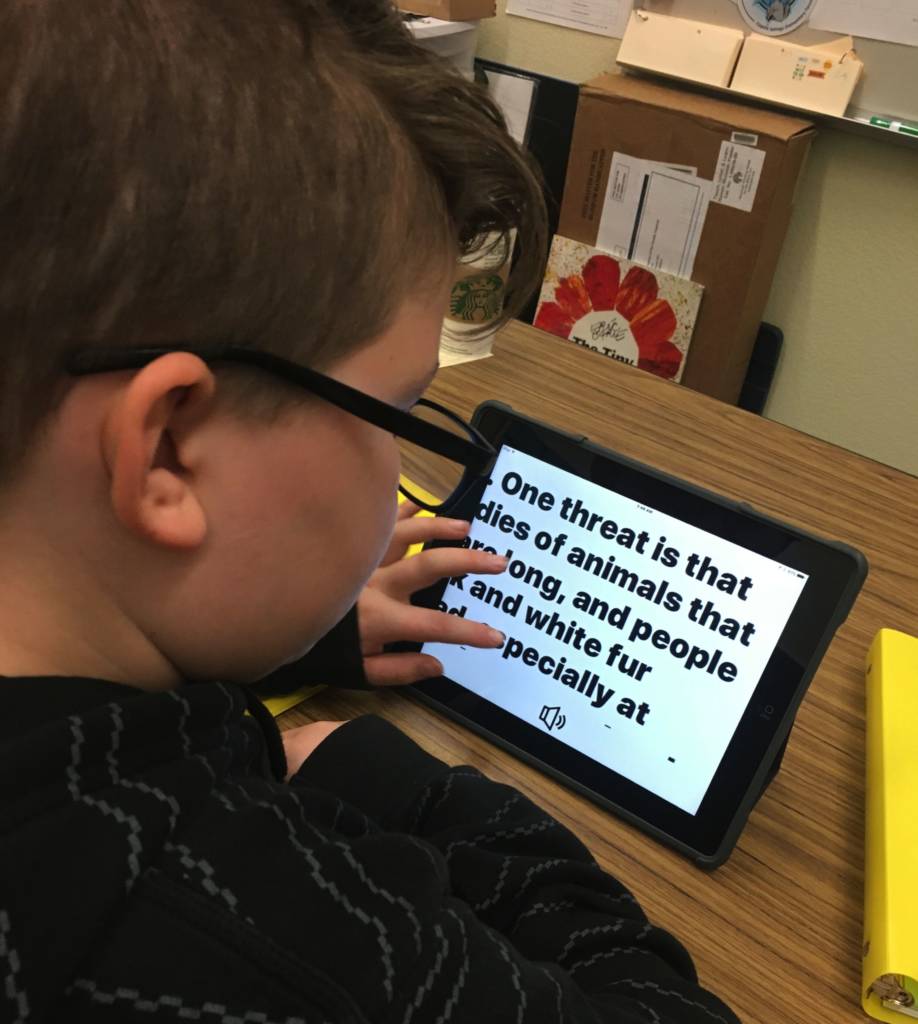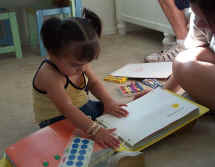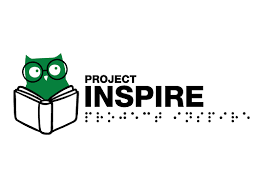By Kate Hurst
Storytelling, like many other skills, is not something we are born doing. Storytelling ties to cognitive development as well as social and emotional development. For example, we have to acquire the ability to hold a sequence of events in memory and recall them; we have to have some form of expressive communication so that we can intentionally convey these events to another person; and we have to be socially and emotionally mature enough to want and be able to share our “story” with another person. How do we learn these skills and when is a learner ready to start creating or co-creating stories?
If you are a parent or educator, it is important to recognize that not every child is ready to co-create stories, and there are strategies you can use to help a child become ready to do this. In fact, you are probably already doing many of these things.
Before we talk about specific strategies let’s think about how we learned to tell a story. Like many other people, my first experience with stories occurred around the family dinner table in the evening, the one time of day all of the family was sure to gather. Mom, Dad and all of my siblings had things to report about how they had spent their days. Generally, these were just conversations, but sometimes an event became a story.
So what can we learn about strategies for helping a child learn storytelling?
Offer Stories, Poems, and Songs
Part of learning about storytelling comes from hearing stories. These can be stories that are about things that happen to your child or to the people he or she knows and cares about. They can also be stories that you read to your child on a regular basis. Every parent probably knows of a story or rhyme or even a song that your child loves to hear over and over again. Sometimes the child will even be able to tell part of the story or cue you to what comes next. For a child who is visually impaired with other additional disabilities this might consist of a gesture, body movement, single word or phrase, or even a sound that is meaningful. Pay close attention to what your child does with his or her body, hands or vocalizations during your storytelling.
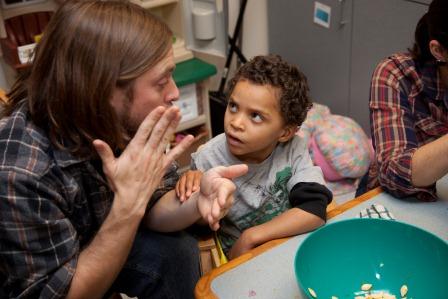
Build a special and consistent time for storytelling–it can be bedtime, Saturday mornings, after school time.
Try to find a special and unique place for storytelling–one parent always told stories in the car, Use special words or cues to signal story time (e.g. “Once upon a time,” or presentation of a story box with objects that will be referenced in the story) and to continue it (“and then,” “next”) and to end the story (“and they lived happily ever after,” “the end”). For children with limited hearing, the cadence, tone of voice, and rhythm of your speech or your facial expression might set storytelling apart from other types of communication.
Story time is a time to model the “non-instrumental” communication functions of language–making silly sound effects to play with the language, reporting on past events or planning the future.” The cadence, tone of voice, and rhythm of your speech or your facial expression might set storytelling apart from other types of communication.
It might also help to build anticipation and trust as the structure of your storytelling activity is consistent and predictable. One parent, who had modeled storytelling repeatedly during car rides, was surprised and delighted when her son initiated storytelling after buckling his seat belt, saying “Once upon a time?” She was delighted and surprised, because he had only used his language in the past to request food, people or favorite activities (“instrumental uses of communication). Now he was using his words to share a special activity that they both enjoyed.
Include Movement Paired with the Story
Children learn through movement at the earliest developmental levels. Pairing movement with stories, songs, and rhymes is a great way to engage your child in a story and to help them be able to recall the series of events it recounts. Rhymes like “Pat-a-Cake” or “Itsy-Bitsy Spider” are several examples of this. Initially the child may not have the attention span to hear a long story, so these short, predictable rhymes paired with movement are a great place to start.
Even when you are recounting an experience you shared with the child, adding physical movement as part of the story is beneficial. For example, a trip to park might include throwing leaves, patting a dog, or smelling a flower. Acting out these things as you tell the story both engages the child and helps them to recall the experience. Be sure to note which things the child found most interesting in the experience to include in the story you recall.
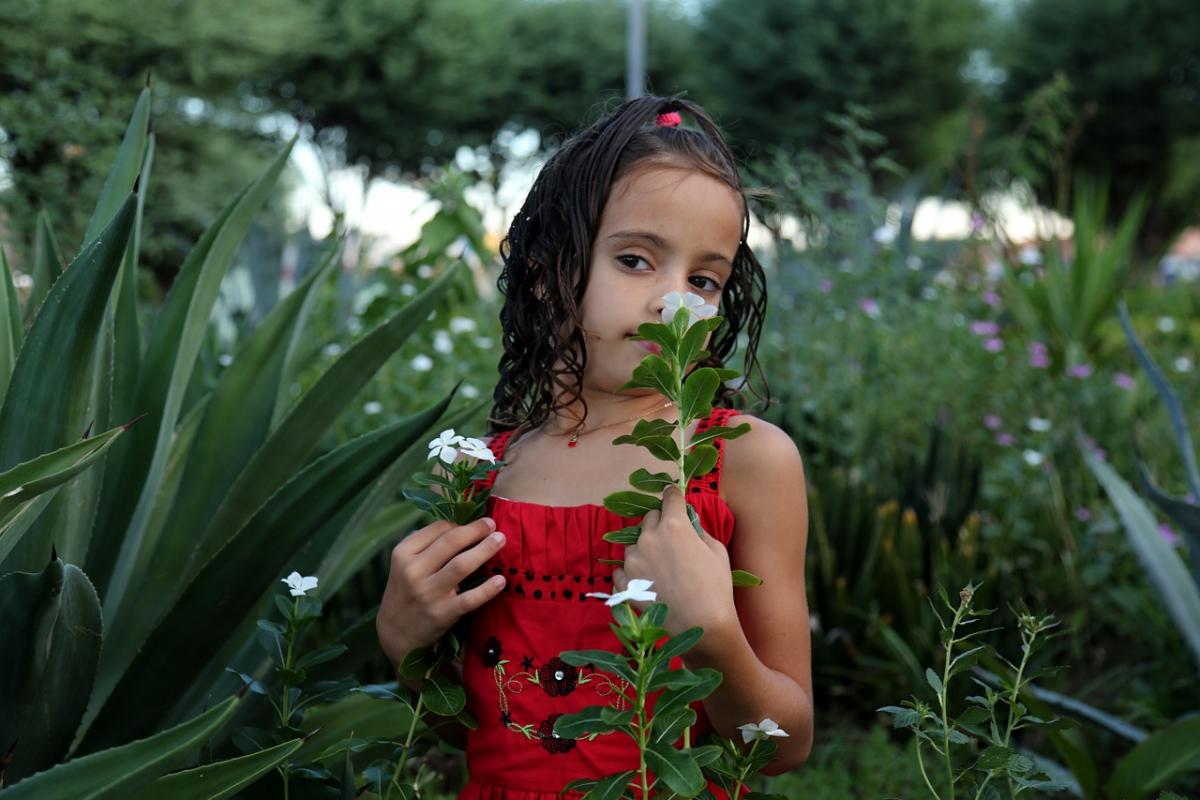
Offer Real Objects or Props
Educators have long relied on experience books and boxes to create a story for a child who has emerging language skills. Real objects should be used initially to represent parts of the event or story. At first the child might not relate to these if the objects are unfamiliar. The ability to represent something with a model, part of an object or a picture may not be present at first.
Consider making stories about familiar everyday events like breakfast time, bath time or bedtime. Be sure to give the child plenty of time to explore the objects in a way that he or she chooses. Watch what the child does with the offered object and imitate her actions with a duplicate object so the child knows that you see what she is doing. Tell the story immediately before the activity and immediately after the activity. Don’t interrupt the child’s activity to comment, unless the child takes a break. Then keep your comments simple, with short phrases or single words. For example, offer a washcloth before a bath and let the child feel you rubbing it on your own arm and (if possible) on his while you say, “rub, rub, rub”. In other words, use the routine as a basis for learning the structure of beginning, middle, and end.
Learn more about Props and Enactment.
Play Interactive Turn-taking Games
Creating games that are repetitive and have opportunities for the child to signal a next step or take a turn is another great strategy for building skills that lead to storytelling. Initially the child may only make a movement or vocalize to request continuation of the activity. Over time take pauses in the “story” you are telling by waiting for the child to do something to indicate what the next action will be. For example, if the game is about tickling his belly after you walk your fingers up his arms, wait to see if the child with hold out his arm to start the game. Pause when you get to the top of the arms to see if the child moves his hands towards his belly or tries to pull your hands to his belly.
The goal is to expand his expressive communication to indicate anticipation of what comes next. Eventually you can pair objects or object symbols or, for some children who have enough vision, a picture to create a story that can be shared at a time and place apart from the experience.
Create Experience Stories with the Child
As the child’s social, emotional, cognitive, and communication skills grow, you may be able to have the child help in creating an experience story. It is important to note that this may take a long time for many children who face multiple challenges such as deafblindness, seizure disorders, or physical impairments. In that case, we continue to use the previous strategies on a regular basis to help them become ready to share the work of creating an experience story with us.
At first, the adult may take the lead in creating the story by using a sequence box or pages of a book with the object or symbol attached to it to represent parts of the story sequence. See if the child can help you organize what comes next in the sequence box.
Later on the child might collect items from the experience and spend time with the adult exploring the objects and pairing them with a name, sign, gesture, signal, or drawing. These objects (static communication forms) can then be sorted into a sequence box or placed in order in an experience book as you recount the events through dynamic communication forms (words, gestures, signals, signs).
Storytelling is a learned skill that starts with simple activities that are predictable and have a “beginning, middle and end”. If your child is not yet ready to tell a story, help build these skills throughout the day through familiar activities and playful moments. Look for signs that your child is ready to share the work in telling the story, such as a gesture or sound for what comes next. Remember, for the child with limited expressive language, any movement with the body may have meaning. Make storytelling a daily part of your child’s life. Both you and your child will find it rewarding and you will be helping him to learn important cognitive, social and emotional skills along the way.

